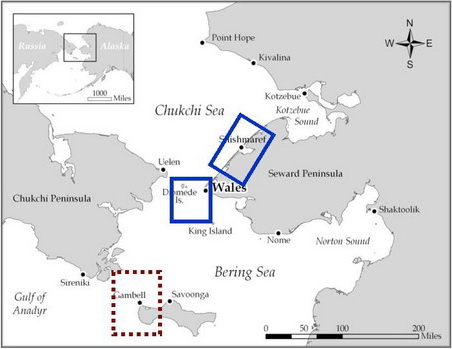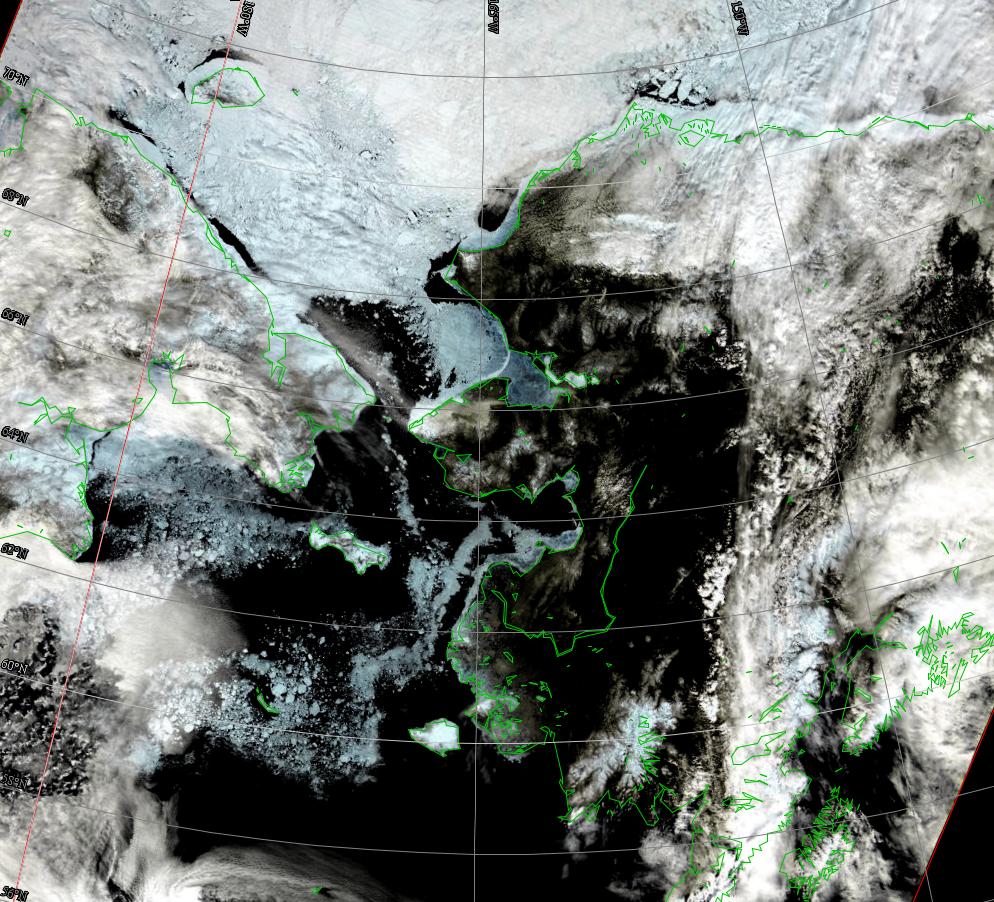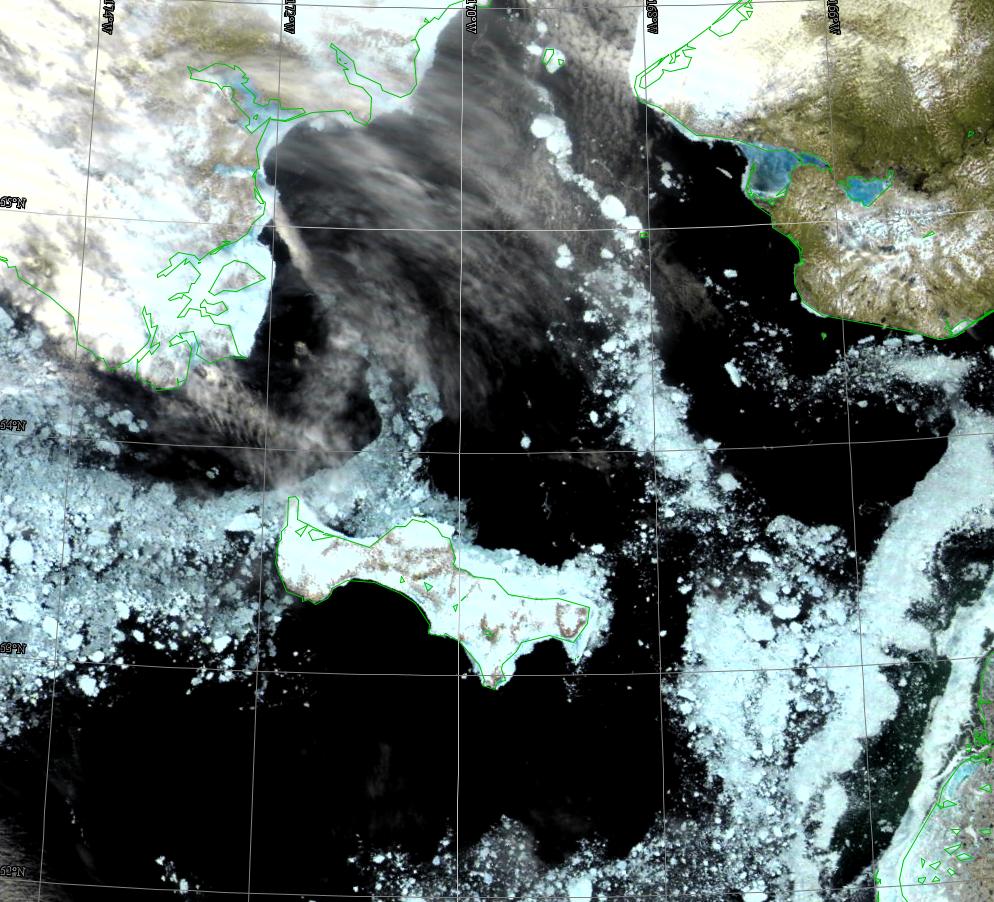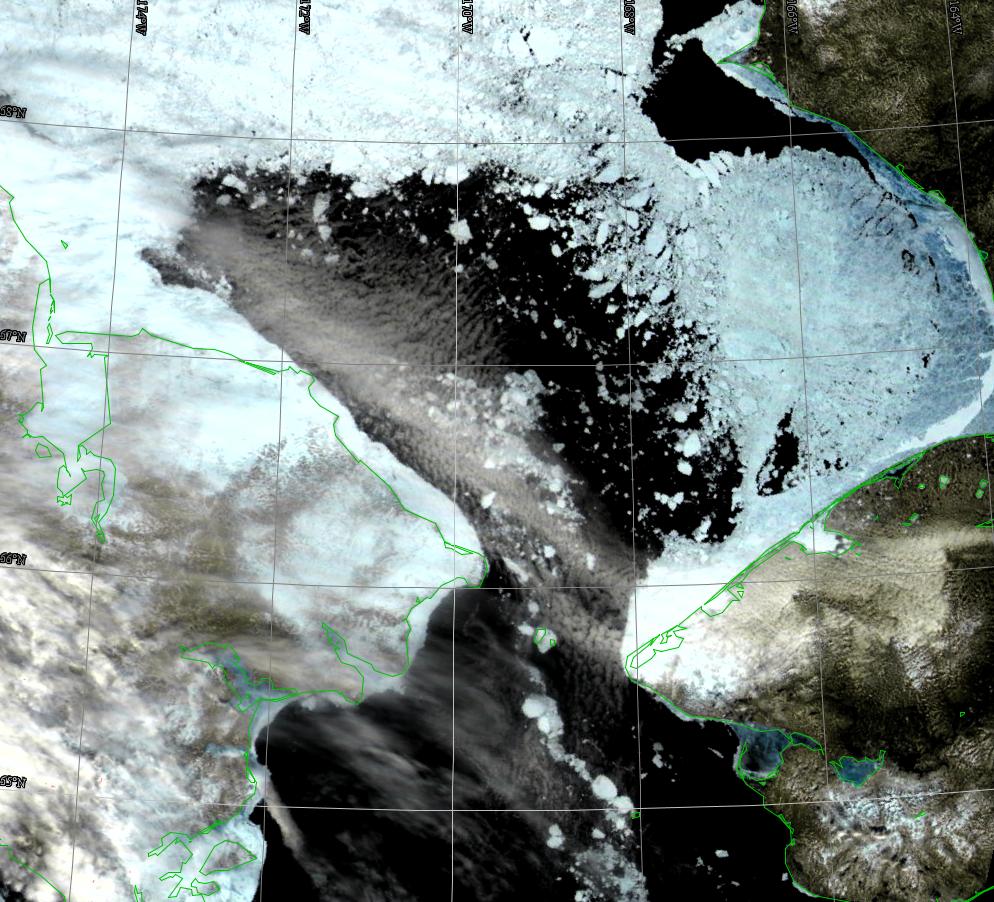Assessment of Current Ice Conditions Relevant to Distribution and Access of Walrus
St. Lawrence Island
There is a heavy concentration of ice floes on the west and northwest corner of St. Lawrence Island (see satellite image). Much of this ice is coming out of the Gulf of Anadyr. Shorefast ice is still present along the north shore. Sea ice northwest of St. Lawrence is streaming northward.There is still a lot of sea ice 80 miles south of St. Lawrence Island.
Wales to Shishmaref
Ice floes continue to stream in a narrow band northward through the Bering Strait 25 miles offshore of Wales. Shorefast ice is still present along the shore (see satellite images). Shorefast ice off Shishmaref continues to hold fast. Ice continues to slowly drift northward.
5 to 10 Day Outlook
A low pressure system in the northern Gulf of Alaska and high pressure over the northern Bering Sea continues through much of the weekend. This will keep the winds light, generally less than 15 knots (20 mph). Winds will increase to SE 25 knots (30 mph) Sunday night but high pressure returns on Monday and the winds will again be light, generally out of the north and less than 15 knots (20 mph). This high pressure is forecast to remain over the northern Bering Sea and Bering Strait through Monday, 11 June.
Arrows show wind direction and wind speed in knots



Remote Sensing Images



Observations and Comments
Observations of Sea Ice Development
Comments from Gambell
2 June 2012 - Paul Apangalook
Although the ice in the area drifted out leaving more open water, more ice drifted in from the southwest bringing with it pockets of concentrated walrus hauled out near the village making our annual harvest easier. We experienced ample game nearby with lots of ice providing azigutaq (protection from rough open waters).
This is the first time that the month of May passed with ice still present in our area. With calmer weather prevailing, we continue to see ice drifting in from the west and southwest. The temperatures have generally been cooler. This is by far the closest spring to the weather trends of the early 1960s.
The other day (31 May) many boats went out, and reported walrus hauled out northwest at about 12 miles and beyond. Some migrating walrus were often encountered in the water. Another boat had gone 33 miles northeast and ran into an area where male walrus were hauled out.
Comments from Shishmaref
1 June 2012 - Curtis Nayokpuk
Over a dozen Bearded seals were taken by hunters. The harvest has been slow due to limited access to open leads and daily coastal fog. Hunters have begun pulling back from a western 20 mile hunting area, because west wind and current moved pack ice in, closing leads; also, there have been reports of trail conditions deteriorating. Bearded seals brought in by hunters appear to be healthy and we hope northward spring migration continues with healthy marine mammals leaving the weak and sickly behind in wintering areas.
Comments from Wales
1 June 2012 - Winton Weyapuk
Temperatures have been cold, keeping the shorefast ice still quite solid except for parts that broke off due to wave action. Usually warm temperatures rot the ice and cracks and sections easily break off. Warmer temperatures will probably accelerate the rotting and breaking up of the shorefast ice soon.
The shorefast ice edge is now about one quarter mile from the beach at the south end of the village. In the past few days scattered floes were seen moving north with the current in open water beyond the shorefast ice edge. Some of these floes are likely tuangniq -- pieces of shorefast ice broken off south of Wales.
A hunting crew from Teller visited earlier in the week and reported that the shorefast ice broke off below Cape Mountain creating a good boat launching site. The crew had a rough ride back on 27 May with fairly large swells from the North.
General Comments
31 May 2012 - Carleton Ray, University of Virginia
I have reviewed all weeks of the 2012 SIWO through early May. In general, this abnormal (isn't it?) year is reminiscent of my days at Gambell on icebreakers in the late 50s through early 80s. The dates of spring whaling (late April-early May) and of first walrus (first week of May) are right on according to my earlier experience. May 15th was the date that Bud Fay suggested as the peak of walrus calving (and hunt). And the final dates for "last ice" with baby seals (except bearded which came earlier), were the first week of June. All these dates look that way this year.
I can't be more specific, unfortunately. The major thing I think needs checking is the ice SW of Gambell and into the Gulf of Anadyr. Looks like a lot of open water there. The big polynya south of Chukotka (Kelliighineq, according to Igor Krupnik) is also striking. So, maybe most walruses these days are coming from the Russian side in the Gulf of Anadyr, except for those, of course, from the Bristol Bay group that arrive later. The problem is that MODIS doesn't detect scattered, smaller floes on which most walruses usually occur during migration. We really do need better resolution. For example, those large "open-water" polynyas south of land masses may actually be covered, at least in part, by ice up to 6" thick, which both walruses and whales easily break through. Floes of less than 250m diameterwon't be detected by MODIS, unless associated into patches -- smaller floes are excellent walrus habitat. Vague signs of such patches are evident for all weeks this year in the area between St. Lawrence and SE Chukotka. It might be possible to confirm those patches' existence if the time and dates of successful hunts were specified to the nearest few miles by hunters carrying GPS, later to be posted in SIWO reports.
